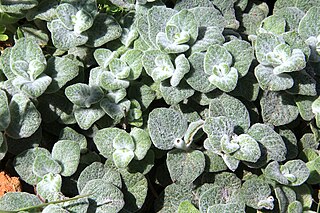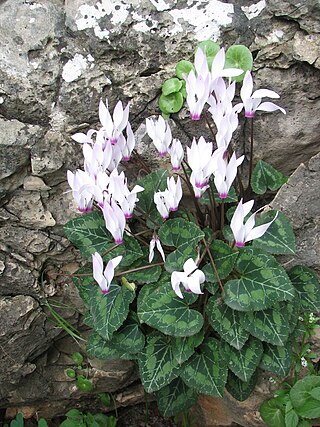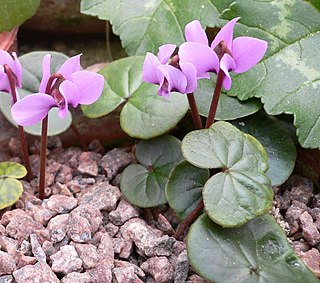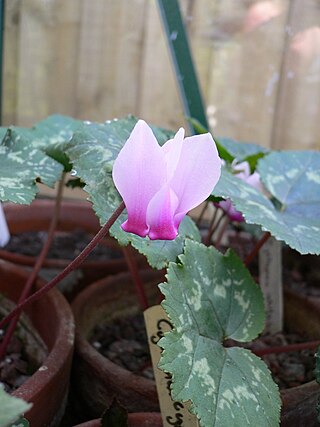
Pelargonium is a genus of flowering plants that includes about 280 species of perennials, succulents, and shrubs, commonly called geraniums, pelargoniums, or storksbills. Geranium is also the botanical name and common name of a separate genus of related plants, also known as cranesbills. Both genera belong to the family Geraniaceae. Carl Linnaeus originally included all the species in one genus, Geranium, and they were later separated into two genera by Charles Louis L'Héritier de Brutelle in 1789.

Cyclamen is a genus of 23 species of perennial flowering plants in the family Primulaceae. Cyclamen species are native to Europe and the Mediterranean Basin east to the Caucasus and Iran, with one species in Somalia. They grow from tubers and are valued for their flowers with upswept petals and variably patterned leaves.

Origanum dictamnus, the dittany of Crete, Cretan dittany or hop marjoram, is a tender perennial plant that grows 20–30 cm high. It is known in Greek as δίκταμο or in the Cretan dialect as έρωντας. It is a therapeutic and aromatic plant that grows wild only on the mountainsides and gorges of the Greek island of Crete. It is widely used for food flavouring and medicinal purposes, in addition to featuring as an ornamental plant in gardens. This small, lanate shrub is easily recognised by the distinctive soft, woolly covering of white-grey hair on its stems and round green leaves, giving it a velvety texture. Its tiny rose-pink flowers are surrounded by brighter purple-pink bracts in summer and autumn. The dittany is classified as vulnerable on the IUCN Red List of Threatened Plant Species 1997.

Cyclamen graecum, the Greek cyclamen, is a perennial plant in the flowering plant family Primulaceae that grows from a tuber. It is native to southern Greece, southern Turkey and neighboring islands and is prized for its variable leaf forms, which include some of the most striking of any cyclamen.
Salvia recognita is a woody-based perennial that is endemic to central Turkey, typically growing in light shade at the base of cliffs, at elevations of less than 4,000 feet (1,200 m). It contains a low concentration of salvinorin A, at approximately 213 micrograms per gram of plant material.

Cyclamen hederifolium, the ivy-leaved cyclamen or sowbread, is a species of flowering plant in the family Primulaceae. This widespread cyclamen species is widely cultivated and among the most hardy and vigorous in oceanic climates. It is native to woodland, shrubland, and rocky areas in the Mediterranean region from southern France to western Turkey and on Mediterranean islands, and naturalized farther north in Europe and in the Pacific Northwest.

Cyclamen purpurascens, the Alpine, European or purple cyclamen, is a species of flowering plant in the genus Cyclamen of the family Primulaceae, native to central Europe, northern Italy, and Slovenia. It is an evergreen tuberous perennial with (usually) variegated leaves, and deep pink flowers in summer.

Cyclamen coum, the eastern sowbread, is a species of flowering plant in the family Primulaceae. It is a tuberous herbaceous perennial, growing to 5–8 cm (2–3 in), with rounded heart-shaped leaves and pink shell-shaped flowers with darker coloration at the base. It is valued in horticulture as groundcover, and for the flowers which bloom in winter and early spring.

Cyclamen persicum, the Persian cyclamen, is a species of flowering herbaceous perennial plant growing from a tuber, native to rocky hillsides, shrubland, and woodland up to 1,200 m (3,900 ft) above sea level, from south-central Turkey to Lebanon-Syria and the Palestine region. It also grows in Algeria and Tunisia and on the Greek islands of Rhodes, Karpathos, and Crete, where it may have been introduced by monks. Cultivars of this species are the commonly seen florist's cyclamen.

Cyclamen cilicium is a species of flowering perennial plant in the family Primulaceae. It is native to coniferous woodland at 700–2,000 m (2,300–6,600 ft) elevation in the Taurus Mountains of southern Turkey.

Cyclamen parviflorum, the small-flowered cyclamen is a flowering perennial plant growing from a tuber, native to high elevations in the Pontic Mountains of northern Turkey. It is the smallest cyclamen species and the only one native to alpine tundra.

Cyclamen rohlfsianum is a species of perennial plant in the family Primulaceae. It is endemic to Libya. It grows from a tuber in shrubland, especially in limestone cracks, up to 450 m (1,500 ft) above sea level. It is one of the tenderest cyclamen species. The plant was discovered by Friedrich Gerhard Rohlfs in 1879, and was named after him in 1897 by Paul Friedrich August Ascherson.

Cyclamen alpinum is a perennial plant growing from a tuber, native to an area of southwestern Turkey, northwest of Antalya. It is isolated from other species of the Cyclamen coum group.

Cyclamen repandum, the spring sowbread, is a species of flowering plant in the family Primulaceae, native to southern Europe and some Mediterranean islands. It is the most widespread of a group of cyclamens with wide, heart-shaped leaves, often coarsely toothed or lobed, and late spring-blooming flowers with long, slender petals.

Cyclamen africanum is a species of flowering plant in the family Primulaceae. It is referred to by the common name African cyclamen and is a perennial growing from a tuber, native to northern Algeria, Morocco and Tunisia. It is similar to Cyclamen hederifolium, but not frost-hardy.

Cyclamen pseudibericum, the false Iberian cyclamen, is a species of flowering plant in the genus Cyclamen of the family Primulaceae, native to the Amanus or Nur and Anti-Taurus Mountains in southern Turkey. It is an herbaceous, tuberous perennial growing to 12 cm (5 in). It is similar to Cyclamen coum, but with longer petals.

Cyclamen mirabile, sowbread, is a species of flowering plant in the primrose family Primulaceae. A tufted, tuberous herbaceous perennial growing to 10 cm (3.9 in), it is native to Turkish pine woodland and maquis in southwestern Turkey. It belongs to the Cyclamen cilicium group of the genus Cyclamen. The species was identified and named in 1906.

Cyclamen rhodium is a species of flowering plant in genus Cyclamen of the family Primulaceae, native to the Peloponnese, Rhodes, and southwestern Kos. It is a tuberous perennial growing to 10 cm (4 in), with mottled, heart-shaped leaves and pink flowers, darker carmine pink at the base, appearing in spring. Like all cyclamens, the flowers consist of five upswept, reflexed petals.
Prasophyllum fitzgeraldii, commonly known as FitzGerald's leek orchid, is a species of orchid endemic to South Australia. It has a single tube-shaped leaf and up to thirty five green or reddish-brown flowers with a pink to purple labellum. It was previously thought to also occur in Victoria.
Prasophyllum roseum, commonly known as the pink lip leek orchid, is a species of orchid endemic to southern continental Australia. It has a single tube-shaped leaf and up to thirty greenish flowers with a pink labellum. It is a recently described plant, previously included with P. fitzgeraldii, but distinguished from that species by its smaller, less crowded flowers, with more spreading lateral sepals and different labellum callus. It grows in the south-east of South Australia and in western Victoria.



















